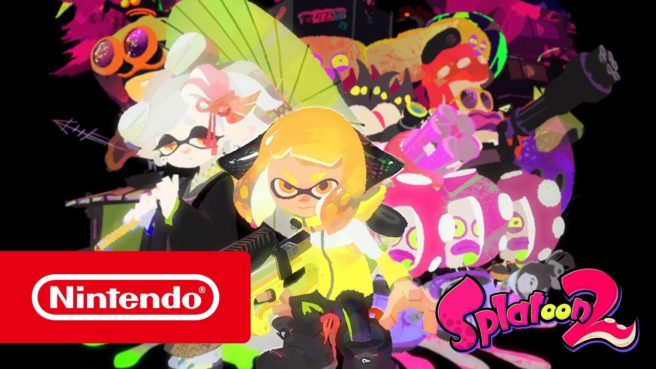Splatoon 2 devs on improvements and adjustments from the first game, Salmon Run, story, future updates
Famitsu published a lengthy Splatoon 2 feature this week. Among the coverage was an interview with four of the game’s developers. Art director Seita Inoue, lead programmer Shintaro Sato, director Yusuke Amano, and producer Hisashi Nogami participated in the talk.
The developers weighed in on Splatoon 2’s improvements and adjustments from the first game, the new Salmon Run mode, the story, and future updates. Among the things discussed were Nintendo’s approach to Salmon Run, how Nintendo considered announcing a Splatoon sequel during the first game’s final Splatfest, a tease of more new weapon categories, and more. The developers were even asked if Marina is an Octoling.
You can find a comprehensive summary of important points from Famitsu’s interview below.
Improvements
For Splatoon 2, the shading mechanism has been totally changed. Thanks to this, gear texture quality is significantly improved.
The team intentionally kept the general look from the original since that was one of the things people loved. However, because of this, people may think they just ported over existing assets from the original to Splatoon 2. In actuality, all graphical aspects and programming mechanisms have been built up from scratch.
The maximum resolution is 1080p in TV mode, but Nintendo put more focus on maintaining a rock solid 60 frames per second, so occasionally the resolution will be scaled down when there is too much ink displaying on the screen. But in any case, the game maintains a more stable 60 frames per second unlike the original.
In order to hold steady at 60 frames per second, Nintendo reduced the CPU load and refined the way to use CPU power effectively. Note that Splatoon 2 drops down to 30 frames per second in Inkopolis Square since it isn’t relevant to battle.
Adjustments
Nintendo tried to adjust the game balance so that original players wouldn’t feel a sense of incongruity when using a weapon they loved to use in the last game. The way they went about adjustments was to let players be more creative by thinking about how to use the best of the weapon or situation and emphasize unique characteristics of each weapon. They didn’t simply balance weapons by loading them up with buffs and nerfs.
In the original Splatoon, special weapons were designed to let players feel their special strength instantly when used, but in the sequel, these weapons are designed to be effective when they used during the right occasion. Special weapons are stronger than the original ones when you use them in an effective situation, but weaker if you use them without considering the situation.
Later in the interview, it’s noted that the damage and effect of slowing down your movement when you step in the opponent’s ink are reduced from original.
Also, as explained in the Splatoon Direct, you can jump up in rank if you’re good enough, but only up until S. That means you can’t jump up from C, B or A to S+.
When you win battles in Ranked mode, the Ranked meter fills and your rank goes up when its fully filled. When you lose a battle, the gauge does not decrease, but the meter starts to crack and once it reach its limit, it breaks. When the meter breaks, you have to start over again from the beginning or from a lower rank.
The highest rank is still S+, but if you fill up the Ranked meter, you get numbers after the alphabet such as “S+1”, “S+2” and so on. The maximum number is “S+50”. However, this number will not be displayed to your opponent and you only can check it on your own status screen.
There is a new value in Splatoon 2 called Ranked Power. Ranked Power is calculated by an algorithm to measure how strong each player is with minuteness. It is used to determine if a player’s rank is worth receiving a big jump (like from “C” to “A”). Ranked Power has no relation with your kill rate, as it’s more tied into to how well you could lead your team to victory. Also, you won’t drop off more than one rank even if you play poorly.
In the original Splatoon, the stage rotation time was fixed to four hours because the developers were expecting players would play only for an hour or so during the four hour rotation. But actually, players were playing continuously. So they changed the timing from four hours to two hours in Splatoon 2.
